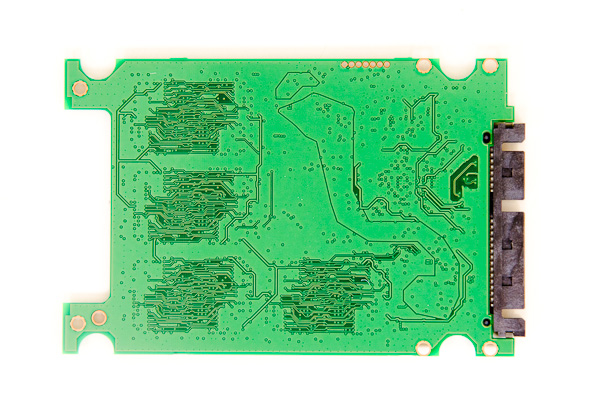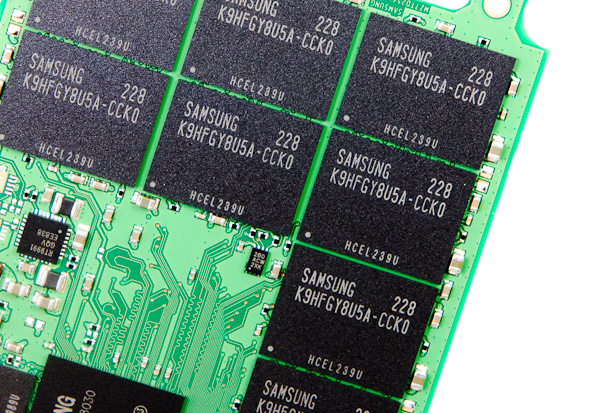Samsung SSD 840 Pro (256GB) Review
by Anand Lal Shimpi on September 24, 2012 7:00 AM EST- Posted in
- Storage
- SSDs
- Samsung
- Samsung SSD 840
If we had an award for most improved in the SSD space, it would have to go to Samsung. When we first encountered Samsung MLC drives a few years ago they were pretty bad. Prices were high and performance was low. Samsung offered no end-user upgradable firmware for those early drives either, although that was eventually rectified. The first Samsung MLC SSDs were reliable, they just weren't worth the money when you had much better options from companies like Intel.
Samsung had all of the right pieces for success however. Like Intel, Samsung made its own NAND, controller and wrote its own firmware. Unlike Intel, Samsung stuck to the vertically integrated formula.
I remember arguing with Samsung engineers a few years ago about the importance of random IO performance compared to sequential speed. I remember feeling like they were making the same mistake that all SSD makers were making back then: heavily prioritizing sequential IO when it was a failure to deliver good random IO performance as well that really hurt SSD adoption. Although the first Samsung SSDs weren't very good, they got better over time. While the first generation couldn't be recommended, the Samsung SSD 470 could. It still wasn't our favorite drive, but it finally brought performance up to a reasonable level. Last year's 830 release showed us that Samsung woke up. Today, Samsung is adding two new members to the family: the Samsung SSD 840 and the 840 Pro. The former is the first productized consumer SSD to use Samsung's 21nm 3-bit-per-cell MLC (aka TLC) NAND, while the latter is Samsung's new flagship drive using 21nm 2bpc MLC NAND.
Unfortunately we don't have samples of the unique TLC SSD 840, just the MLC 840 Pro. Despite the use of TLC NAND, Samsung claims the vanilla 840 should offer similar performance to the current 830. Samsung also claims that endurance should be reasonable for consumer workloads.
The 840 Pro should be tangibly faster than the 830 thanks to a new controller, new firmware and new NAND:
| Samsung SSD 840 Pro vs 830 | ||||
| Samsung SSD 830 (256,512GB) | Samsung SSD 840 Pro (256,512GB) | |||
| Sequential Read | 520MB/s | 540MB/s | ||
| Sequential Write | 400MB/s | 450MB/s | ||
| Random Read | 80K IOPS | 100K IOPS | ||
| Random Write | 36K IOPS | 78K IOPS | ||
| Active Power Use | 0.24W | 0.068W | ||
| Idle Power Use | 0.14W | 0.042W | ||
While the 830 used Samsung's 27nm MLC NAND, the 840 Pro uses Samsung's latest 21nm MLC NAND. The move to 21nm will eventually drive NAND pricing lower, although today Samsung expects price parity between the TLC equipped 840 and the old MLC 830. The 840 Pro should sell for a 25 - 30% premium over the current 830.
| Samsung SSD 840 Pro Pricing | ||||||
| 64GB | 128GB | 256GB | 512GB | |||
| Samsung SSD 840 Pro | $99.99 | $149.99 | $269.99 | $599.99 | ||
The move to 21nm is also coupled with a move to a 400Mbps Toggle 2.0 NAND interface. Block and page sizes remain the same for 2bpc MLC 21nm NAND, and maximum capacity per die is still 8GB. Although beyond the scope of this article, 3bpc TLC 21nm NAND sees 50% slower program/erase times compared to the 2bpc MLC 21nm NAND.
Both the 840 and 840 Pro use Samsung's 4th generation SSD controller. Samsung's MAX controller was used in the SSD 470, its successor, the MBX controller, wasn't used in retail drives, while MCX debuted in the 830 and MDX is in the 840/840 Pro. The basic architecture of the controller hasn't changed. Internally there are three ARM9 cores now running at 300MHz. Update: Samsung originally listed ARM9 cores but has since told us that there are three ARM Cortex R4s inside of the new MDX controller.
The MDX controller features a hardware AES-256 encryption engine that's managed using a system BIOS password like most other drives in this class.
The MDX controller is paired with 512MB of LPDDR2-1066 in the Samsung SSD 840 Pro, doubling up the DRAM used in the 830 as well as increasing bandwidth to DRAM by 33%:
| SSD DRAM Size Comparison | |||||
| Drive | Controller | DRAM Size | DRAM Speed | ||
| Corsair Neutron GTX | LAMD LM87800 | 256MB | DDR2-800 | ||
| Crucial m4 | Marvell 88SS9174 | 256MB | DDR3-667 | ||
| Intel SSD 320 | Intel X25-M G3 | 64MB | SDR-166 | ||
| Intel SSD 520 | SandForce SF-2281 | 0MB | - | ||
| OCZ Vertex 4 | Indilinx Everest 2 | 512MB/1GB | DDR3-800 | ||
| Samsung SSD 830 | Samsung MCX | 256MB | DDR2-800 | ||
| Samsung SSD 840 Pro | Samsung MDX | 512MB | LPDDR2-1066 | ||
The 840 Pro will be available in 64 - 512GB capacities. Although the controller supports up to 1TB of NAND, Samsung believes that the ultra-high-density NAND required to hit 1TB is too cost prohibitive at this point. Spare area is set at around 7% by default, although users will be able to adjust it via Samsung's SSD Magician utility. The vanilla 840 on the other hand will boast more spare area (likely to help manage endurance on the TLC NAND) and will launch at 120GB, 250GB and 500GB capacities as a result.

The 256GB SSD 840 Pro features 8 x 32GB NAND devices on the front of the PCB and nothing on the back
The 840 comes with a 3 year warranty compared to a 5 year warranty on the 840 Pro.
The 840 Pro drops the brushed aluminum look of the 830 for slightly more modern, flat black styling. The drives will be available in a 2.5" 7mm form factor, similar to the 830.

Samsung SSD 840 Pro (top) vs. Samsung SSD 830 (bottom)
Both drives will be available on October 15th, however in advance of the release Samsung provided us with a beta sample for review. We were only able to get a 256GB 840 Pro initially but we've already asked Samsung for additional capacities. The other bad news is after running through our client test suite and preparing the drive for a run through our enterprise suite, our pre-production sample died. This isn't the first time we've had an SSD die during our test process, pretty much every company has seen a failure during one of our reviews, but despite Samsung's excellent track record even it isn't immune from early issues. These drives are a few weeks away from retail and Samsung will be getting our sample back this week to figure out what went wrong.
Update: My replacement 840 Pro also died, I have shipped both drives back to Samsung and are waiting for their analysis of the failures.
Update 2: It looks like this may have been a firmware issue. Retail drives should ship with fixed firmware.
The Test
| CPU |
Intel Core i7 2600K running at 3.4GHz (Turbo & EIST Disabled) - for AT SB 2011, AS SSD & ATTO |
| Motherboard: |
Intel DH67BL Motherboard |
| Chipset: |
Intel H67 |
| Chipset Drivers: |
Intel 9.1.1.1015 + Intel RST 10.2 |
| Memory: | Corsair Vengeance DDR3-1333 2 x 2GB (7-7-7-20) |
| Video Card: | eVGA GeForce GTX 285 |
| Video Drivers: | NVIDIA ForceWare 190.38 64-bit |
| Desktop Resolution: | 1920 x 1200 |
| OS: | Windows 7 x64 |













96 Comments
View All Comments
iwod - Tuesday, September 25, 2012 - link
True but i think there will be a bottleneck somewhere else once we hit certain number of Random Read. Anand already has results that any more then 40~50MB/s random wrote give us any more benefits. I think it would be similar for Random Read as well although we have so far not reach that point yet.Of coz these results are with today's software. Things could be different again when we reach that limit.
leboon - Monday, September 24, 2012 - link
Thanks for the review. I must say that the random comments interspersed throughout the article about the regular 840--which isn't even being reviewed-- seemed rather strange and out of place.On topic though, this new Samsung drive looks very promising and I'm looking forward to grabbing one of them when they're released, to breathe new life into an aging laptop.
Kristian Vättö - Monday, September 24, 2012 - link
That's because we didn't get any information about the regular 840 until a few hours before the NDA was lifted, but at least I feel like it was still important to note that such drive exists.There will be a review ASAP though. I just came back to my hotel room and found a gift box with a 250GB 840 in it :-)
nathanddrews - Monday, September 24, 2012 - link
"Joy!"-Stimpy
Grok42 - Monday, September 24, 2012 - link
Quit yammering and get to testing and writing! I'm guessing that is the 840 non-pro? Never mind, don't answer that, just focus.dishayu - Monday, September 24, 2012 - link
Active power : 0.068WSurely this has to be a mistake? I can't imagine any drive today with such low active power today.
DanNeely - Monday, September 24, 2012 - link
I'd like to know what Samsung's measuring for that number too; Anand measured the 840 pro an order of magnitude higher during write operations. Unless that number is just for the controller and not for the flash too there's something not right about the gap between that number and what AT's measuring.iwod - Monday, September 24, 2012 - link
I think that is only the controller. You have to include the LP-DDR2 as well.Its Working power is still higher then Intel. Although i dont like sammy, i hope the final product will be even better then this.
LGrill - Monday, September 24, 2012 - link
I was thinking the same thing.ssj3gohan - Monday, September 24, 2012 - link
This is completely correct. Anandtech and basically every other review site out there measures power consumption wrong: they measure it while *not* booted into an OS that supports SATA power management. With DIPM (device initiated power management) enabled, the drive should hit this power consumption easily.Same goes for pretty much every other SATA SSD these days. They're all well below 0.3W idle except for Sandforce drives. For instance, all Intel drives (intel- and marvell-based) are about 75 to 100mW idle.